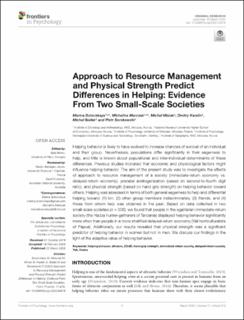| dc.contributor.author | Butovskaya, Marina | |
| dc.contributor.author | Marczak, Michalina | |
| dc.contributor.author | Misiak, Michal | |
| dc.contributor.author | Karelin, Dmitry | |
| dc.contributor.author | Bialek, Michal | |
| dc.contributor.author | Sorokowski, Piotr | |
| dc.date.accessioned | 2022-05-03T10:04:36Z | |
| dc.date.available | 2022-05-03T10:04:36Z | |
| dc.date.created | 2020-11-20T18:33:41Z | |
| dc.date.issued | 2020 | |
| dc.identifier.citation | Frontiers in Psychology. 2020, 11 1-9. | en_US |
| dc.identifier.issn | 1664-1078 | |
| dc.identifier.uri | https://hdl.handle.net/11250/2993858 | |
| dc.description.abstract | Helping behavior is likely to have evolved to increase chances of survival of an individual and their group. Nevertheless, populations differ significantly in their eagerness to help, and little is known about populational and inter-individual determinants of these differences. Previous studies indicated that economic and physiological factors might influence helping behavior. The aim of the present study was to investigate the effects of approach to resource management of a society (immediate-return economy vs. delayed-return economy), prenatal androgenization (based on second-to-fourth digit ratio), and physical strength (based on hand grip strength) on helping behavior toward others. Helping was assessed in terms of both general eagerness to help and differential helping toward: (1) kin, (2) other group members indiscriminately, (3) friends, and (4) those from whom help was obtained in the past. Based on data collected in two small-scale societies (n = 306), we found that people in the egalitarian immediate-return society (the Hadza hunter-gatherers of Tanzania) displayed helping behavior significantly more often than people in a more stratified delayed-return economy (Yali horticulturalists of Papua). Additionally, our results revealed that physical strength was a significant predictor of helping behavior in women but not in men. We discuss our findings in the light of the adaptive value of helping behavior. | en_US |
| dc.description.abstract | Approach to resource management and physical strength predict differences in helping: Evidence from two small-scale societies | en_US |
| dc.language.iso | eng | en_US |
| dc.publisher | Frontiers Media | en_US |
| dc.rights | Navngivelse 4.0 Internasjonal | * |
| dc.rights.uri | http://creativecommons.org/licenses/by/4.0/deed.no | * |
| dc.title | Approach to resource management and physical strength predict differences in helping: Evidence from two small-scale societies | en_US |
| dc.title.alternative | Approach to resource management and physical strength predict differences in helping: Evidence from two small-scale societies | en_US |
| dc.type | Peer reviewed | en_US |
| dc.type | Journal article | en_US |
| dc.description.version | publishedVersion | en_US |
| dc.source.pagenumber | 1-9 | en_US |
| dc.source.volume | 11 | en_US |
| dc.source.journal | Frontiers in Psychology | en_US |
| dc.identifier.doi | 10.3389/fpsyg.2020.00373 | |
| dc.identifier.cristin | 1850558 | |
| cristin.ispublished | true | |
| cristin.fulltext | original | |
| cristin.qualitycode | 1 | |

